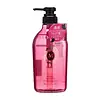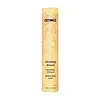What's inside
What's inside
 Key Ingredients
Key Ingredients

 Benefits
Benefits

 Concerns
Concerns

 Ingredients Side-by-side
Ingredients Side-by-side

Water
Skin ConditioningSodium Laureth Sulfate
CleansingCocamidopropyl Betaine
CleansingDipropylene Glycol
HumectantSodium Glycolate
BufferingGuar Hydroxypropyltrimonium Chloride
Skin ConditioningHydroxyethyl Urea
HumectantPolyquaternium-7
Propyltrimoniumchloride Acrylamide/Dimethylacrylamide Copolymer
Lactic Acid
BufferingHoney
HumectantSodium Hyaluronate
HumectantHydrolyzed Conchiolin Protein
Skin ConditioningTea-Sulfate
BufferingLauric Acid
CleansingCitric Acid
BufferingSalicylic Acid
MaskingDisodium EDTA
Ammonium Lactate
BufferingButylene Glycol
HumectantPhenoxyethanol
PreservativeBenzyl Benzoate
AntimicrobialParfum
MaskingWater, Sodium Laureth Sulfate, Cocamidopropyl Betaine, Dipropylene Glycol, Sodium Glycolate, Guar Hydroxypropyltrimonium Chloride, Hydroxyethyl Urea, Polyquaternium-7, Propyltrimoniumchloride Acrylamide/Dimethylacrylamide Copolymer, Lactic Acid, Honey, Sodium Hyaluronate, Hydrolyzed Conchiolin Protein, Tea-Sulfate, Lauric Acid, Citric Acid, Salicylic Acid, Disodium EDTA, Ammonium Lactate, Butylene Glycol, Phenoxyethanol, Benzyl Benzoate, Parfum
Water
Skin ConditioningSodium Lauroyl Sarcosinate
CleansingSodium Cocoyl Isethionate
CleansingCoco-Betaine
CleansingDisodium Laureth Sulfosuccinate
CleansingSodium Lauryl Sulfoacetate
CleansingGlyceryl Distearate
EmollientParfum
MaskingDivinyldimethicone/Dimethicone Copolymer
Carbomer
Emulsion StabilisingDecyl Glucoside
CleansingPhenyl Trimethicone
Skin ConditioningPolyquaternium-10
Amodimethicone
PPG-5-Ceteth-20
EmulsifyingHydroxyethyl Behenamidopropyl Dimonium Chloride
Ozokerite
Emulsion StabilisingGlycereth-26
HumectantPanthenol
Skin ConditioningSodium Hydroxide
BufferingPolyquaternium-7
Sodium Chloride
MaskingC12-13 Pareth-23
CleansingC12-13 Pareth-3
EmulsifyingC11-15 Pareth-7
EmulsifyingGlycerin
HumectantLaureth-9
EmulsifyingTrideceth-12
EmulsifyingCitric Acid
BufferingHippophae Rhamnoides Seed Oil
Skin ProtectingEthylhexylglycerin
Skin ConditioningBenzophenone-4
UV AbsorberTocopheryl Acetate
AntioxidantAloe Barbadensis Leaf Juice
Skin ConditioningBenzyl Alcohol
PerfumingDehydroacetic Acid
PreservativePhenoxyethanol
PreservativeChlorhexidine Dihydrochloride
AntimicrobialPotassium Sorbate
PreservativeSodium Benzoate
MaskingButylphenyl Methylpropional
PerfumingLimonene
PerfumingHydroxycitronellal
PerfumingHydroxyisohexyl 3-Cyclohexene Carboxaldehyde
MaskingWater, Sodium Lauroyl Sarcosinate, Sodium Cocoyl Isethionate, Coco-Betaine, Disodium Laureth Sulfosuccinate, Sodium Lauryl Sulfoacetate, Glyceryl Distearate, Parfum, Divinyldimethicone/Dimethicone Copolymer, Carbomer, Decyl Glucoside, Phenyl Trimethicone, Polyquaternium-10, Amodimethicone, PPG-5-Ceteth-20, Hydroxyethyl Behenamidopropyl Dimonium Chloride, Ozokerite, Glycereth-26, Panthenol, Sodium Hydroxide, Polyquaternium-7, Sodium Chloride, C12-13 Pareth-23, C12-13 Pareth-3, C11-15 Pareth-7, Glycerin, Laureth-9, Trideceth-12, Citric Acid, Hippophae Rhamnoides Seed Oil, Ethylhexylglycerin, Benzophenone-4, Tocopheryl Acetate, Aloe Barbadensis Leaf Juice, Benzyl Alcohol, Dehydroacetic Acid, Phenoxyethanol, Chlorhexidine Dihydrochloride, Potassium Sorbate, Sodium Benzoate, Butylphenyl Methylpropional, Limonene, Hydroxycitronellal, Hydroxyisohexyl 3-Cyclohexene Carboxaldehyde
Ingredients Explained
These ingredients are found in both products.
Ingredients higher up in an ingredient list are typically present in a larger amount.
Citric Acid is an alpha hydroxy acid (AHA) naturally found in citrus fruits like oranges, lemons, and limes.
Like other AHAs, citric acid can exfoliate skin by breaking down the bonds that hold dead skin cells together. This helps reveal smoother and brighter skin underneath.
However, this exfoliating effect only happens at high concentrations (20%) which can be hard to find in cosmetic products.
Due to this, citric acid is usually included in small amounts as a pH adjuster. This helps keep products slightly more acidic and compatible with skin's natural pH.
In skincare formulas, citric acid can:
While it can provide some skin benefits, research shows lactic acid and glycolic acid are generally more effective and less irritating exfoliants.
Most citric acid used in skincare today is made by fermenting sugars (usually from molasses). This synthetic version is identical to the natural citrus form but easier to stabilize and use in formulations.
Read more about some other popular AHA's here:
Learn more about Citric AcidParfum is a catch-all term for an ingredient or more that is used to give a scent to products.
Also called "fragrance", this ingredient can be a blend of hundreds of chemicals or plant oils. This means every product with "fragrance" or "parfum" in the ingredients list is a different mixture.
For instance, Habanolide is a proprietary trade name for a specific aroma chemical. When used as a fragrance ingredient in cosmetics, most aroma chemicals fall under the broad labeling category of “FRAGRANCE” or “PARFUM” according to EU and US regulations.
The term 'parfum' or 'fragrance' is not regulated in many countries. In many cases, it is up to the brand to define this term.
For instance, many brands choose to label themselves as "fragrance-free" because they are not using synthetic fragrances. However, their products may still contain ingredients such as essential oils that are considered a fragrance by INCI standards.
One example is Calendula flower extract. Calendula is an essential oil that still imparts a scent or 'fragrance'.
Depending on the blend, the ingredients in the mixture can cause allergies and sensitivities on the skin. Some ingredients that are known EU allergens include linalool and citronellol.
Parfum can also be used to mask or cover an unpleasant scent.
The bottom line is: not all fragrances/parfum/ingredients are created equally. If you are worried about fragrances, we recommend taking a closer look at an ingredient. And of course, we always recommend speaking with a professional.
Learn more about ParfumPhenoxyethanol is a preservative that has germicide, antimicrobial, and aromatic properties. Studies show that phenoxyethanol can prevent microbial growth. By itself, it has a scent that is similar to that of a rose.
It's often used in formulations along with Caprylyl Glycol to preserve the shelf life of products.
Polyquaternium-7 is a light to clear colored liquid. It is commonly found in haircare products for its film-forming and anti-static properties.
According to a manufacturer, it is a non-paraben and specially developed for negatively charged surfactant systems. This makes it a great hairstyle holder and helps to improve wet hair detangling without adding buildup.
Water. It's the most common cosmetic ingredient of all. You'll usually see it at the top of ingredient lists, meaning that it makes up the largest part of the product.
So why is it so popular? Water most often acts as a solvent - this means that it helps dissolve other ingredients into the formulation.
You'll also recognize water as that liquid we all need to stay alive. If you see this, drink a glass of water. Stay hydrated!
Learn more about Water